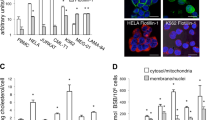Abstract
In the recent years, bioenergetics of tumor cells and particularly cell respiration have been attracting great attention because of the involvement of mitochondria in apoptosis and growing evidence of the possibility to diagnose and treat cancer by affecting the system of oxidative phosphorylation in mitochondria. In the present work, a comparative study of oxygen consumption in 3T3B-SV40 cells transformed with oncovirus SV40 and parental BALB/3T3 cells was conducted. Such fractions of oxygen consumption as “phosphorylating” respiration coupled to ATP synthesis, “free” respiration not coupled to ATP synthesis, and “reserve” or hidden respiration observed in the presence of protonophore were determined. Maximal respiration was shown to be only slightly decreased in 3T3B-SV40 cells as compared to BALB/3T3. However, in the case of certain fractions of cellular respiration, the changes were significant. “Phosphorylating” respiration was found to be reduced to 54% and “reserve” respiration, on the contrary, increased up to 160% in virus-transformed 3T3B-SV40 cells. The low rate of “phosphorylating” respiration and high “reserve” respiration indicate that under normal incubation conditions the larger part of mitochondrial respiratory chains of the virus-transformed cells is in the resting state (i.e. there is no electron transfer to oxygen). The high “reserve” respiration is suggested to play an important role in preventing apoptosis of 3T3B-SV40 cells.
Similar content being viewed by others
Abbreviations
- MPTP:
-
mitochondrial permeability transition pores
- MRC:
-
mitochondrial respiratory chains
- PCD:
-
programmed cell death
- RC:
-
respiratory control coefficients
- RCADP :
-
control of respiration by the system of ATP synthesis from ADP and phosphate
- RCPMF :
-
control of respiration by proton motive force
References
Jose, C., Bellance, N., and Rossignol, R. (2011) Biochim. Biophys. Acta, 1807, 552–561.
Koppenol, W. H., Bounds, P. L., and Dang, C. V. (2011) Nat. Rev. Cancer, 11, 325–337.
Gogvadze, V., Zhivotovsky, B., and Orrenius, S. (2010) Mol. Aspects Med., 31, 60–74.
Moreno-Sanchez, R., Rodriguez-Enriquez, S., Marin-Hernandez, A., and Saavedra, E. (2007) FEBS J., 274, 1393–1418.
Ramsay, E. E., Hogg, P. J., and Dilda, P. J. (2011) Pharm. Res., 28, 2731–2744.
Warburg, O. (1956) Science, 123, 309–314.
Kroemer, G. (1999) Biochem. Soc. Symp., 66, 1–15.
Ouyang, L., Shi, Z., Zhao, S., Wang, F. T., Zhou, T. T., Liu, B., and Bao, J. K. (2012) Cell Prolif., 45, 487–498.
Ferreira, C. G., Epping, M., Kruyt, F. A., and Giaccone, G. (2002) Clin. Cancer Res., 8, 2024–2034.
Aaronson, S. A., and Todaro, G. E. (1968) J. Cell. Physiol., 72, 141–148.
Vasiliev, Yu. M., and Gelfand, I. M. (1981) Interaction of Normal and Neoplastic Cells with the Medium. Problems of Developmental Biology [in Russian], Nauka, Moscow.
Barkan, R. S., and Nikolsky, N. N. (1985) Tsitologiya, 27, 5–26.
Pinaev, G. P. (1988) Methods of Cell Cultivation [in Russian], Nauka, Leningrad.
Ashley, N., Garedev, A., Troppmair, J., Boushel, R., and Gneiger, E. (2005) Mitochondr. Physiol. Network, 10, 55–57.
Pesta, D., and Gnaiger, E. (2012) Mitochondr. Bioenerg.: Methods Mol. Biol., 810, 25–58.
Regis, A., Vilchez, S., and Butel, J. (2004) Clin. Microbiol. Rev., 17, 495–508.
Geoffrey, M. C. (2000) The Cell, 2nd Edn., A Molecular Approach, Chap. 15, Tumor Viruses, Boston University, Sunderland (MA): Sinauer Associates.
Moens, U., Van Ghelue, M., and Johannessen, M. (2007) Cell Mol. Life Sci., 64, 1656–1678.
Ahuja, D., Saenz-Robles, M. T., and Pipas, J. M. (2005) Oncogene, 24, 7729–7745.
Carrino, D., and Gershman, H. (1977) Proc. Natl. Acad. Sci. USA, 74, 3874–3878.
Elvin, P., and Evans, C. W. (1982) Eur. J. Cancer. Clin. Oncol., 18, 669–675.
Colby, C., and Romano, A. H. (1975) J. Cell Physiol., 85, 15–23.
Diamond, I., Legg, A., Schneider, J. A., and Rozengurt, E. (1978) J. Biol. Chem., 253, 866–871.
Yang, D., Wang, M. T., Tang, Y., Chen, Y., Jiang, H., Jones, T. T., Rao, K., Brewer, G. J., Singh, K. K., and Nie, D. (2010) Cancer Biol. Ther., 9, 122–133.
Rodriguez-Enriquez, S., Juarez, O., Rodriguez-Zavala, J. S., and Moreno-Sanchez, R. (2001) Eur. J. Biochem., 268, 2512–2519.
Willers, I. M., and Cuezva, J. M. (2011) Biochim. Biophys. Acta, 1807, 543–551.
Joan, P., Schwartz, J. V., Passonneau, G., Johnson, S., and Pastan, I. (1974) J. Biol. Chem., 249, 4138–4143.
Evtodienko, Y. V., Teplova, V. V., Azarashvily, T. S., Kudin, A., Prusakova, O., Virtanen, I., and Saris, N. E. (1999) Mol. Cell Biochem., 194, 251–256.
Ly, J. D., Grubb, D. R., and Lawen, A. (2003) Apoptosis, 8, 115–128.
Lemasters, J. J., Qian, T., He, L., Kim, J. S., Elmore, S. P., Cascio, W. E., and Brenner, D. A. (2002) Antioxid. Redox Signal., 4, 769–781.
Norberg, E., Gogvadze, V., Ott, M., Horn, M., Uhlen, P., Orrenius, S., and Zhivotovsky, B. (2008) Cell Death Differ., 15, 1857–1864.
Brand, M. D., and Nicholls, D. G. (2011) Biochem. J., 435, 297–312.
Choi, S. W., Gerencser, A. A., and Nicholls, D. G. (2009) J. Neurochem., 109, 1179–1191.
Chen, G., Wang, F., Trachootham, D., and Huang, P. (2010) Mitochondrion, 10, 614–625.
Author information
Authors and Affiliations
Corresponding author
Additional information
Original Russian Text © E. I. Leznev, I. I. Popova, V. P. Lavrovskaja, Y. V. Evtodienko, 2013, published in Biokhimiya, 2013, Vol. 78, No. 8, pp. 1151–1157.
Rights and permissions
About this article
Cite this article
Leznev, E.I., Popova, I.I., Lavrovskaja, V.P. et al. Comparison of oxygen consumption rates in minimally transformed BALB/3T3 and virus-transformed 3T3B-SV40 cells. Biochemistry Moscow 78, 904–908 (2013). https://doi.org/10.1134/S0006297913080063
Received:
Revised:
Published:
Issue Date:
DOI: https://doi.org/10.1134/S0006297913080063




